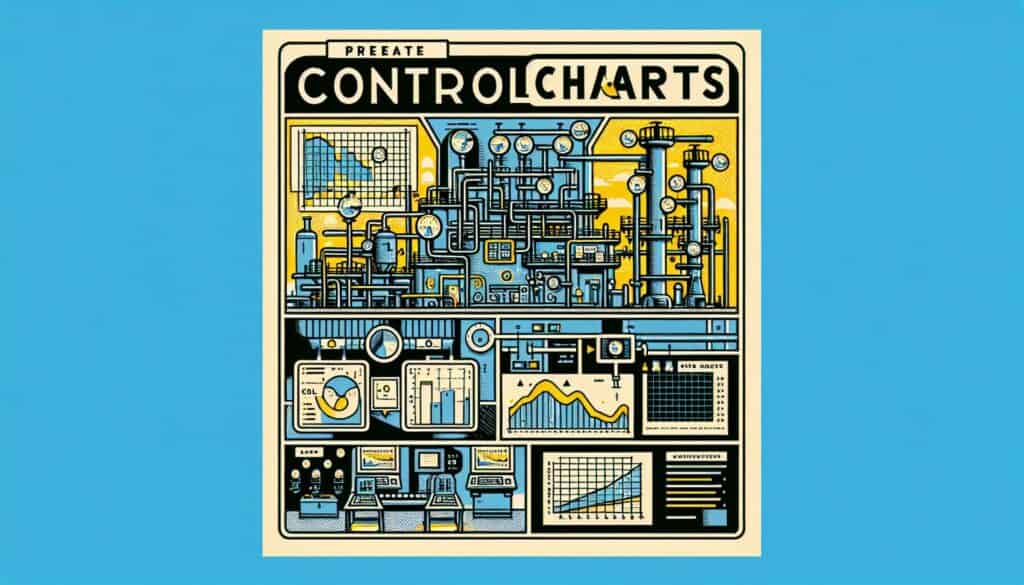Per prevenire la produzione di prodotti non conformi, monitorando le impostazioni del processo all'avvio e durante le corse, utilizzando zone più ampie rispetto alle carte di controllo.
- Metodologie: Ingegneria, Qualità
Grafici di precontrollo

Grafici di precontrollo
- Miglioramento continuo, Prevenzione degli errori, Produzione snella, Capacità di processo, Miglioramento dei processi, Efficienza della produzione, Garanzia di qualità, Controllo di qualità, Controllo statistico del processo (SPC)
Obiettivo:
Come si usa:
- Un semplice strumento statistico in cui gli operatori controllano un piccolo numero di pezzi consecutivi rispetto ai limiti di specifica suddivisi in zone verdi (centro), gialle (attenzione) e rosse (stop). Le regolazioni vengono effettuate in base alla posizione dei pezzi.
Professionisti
- Semplice da capire e da utilizzare da parte degli operatori; fornisce un feedback immediato sulla stabilità del processo; si concentra sulla prevenzione dei difetti piuttosto che sul semplice rilevamento; richiede una minore raccolta di dati rispetto a quelli tradizionali. SPC grafici.
Contro
- Meno rigoroso dal punto di vista statistico rispetto alle carte di controllo di Shewhart; può non rilevare con la stessa efficacia i piccoli cambiamenti di processo; si affida molto alla disciplina dell'operatore e alla sua corretta interpretazione.
Categorie:
- Produzione, Qualità
Ideale per:
- Fornire un metodo semplice, guidato dall'operatore, per controllo di processo nel punto di produzione, particolarmente utile per le basse tirature o nei casi in cui l'SPC completo non è praticabile.
I diagrammi di precontrollo sono uno strumento efficace per la gestione della qualità e possono essere particolarmente vantaggiosi in settori come l'automobilistico, l'elettronico, il tessile e l'alimentare, dove la produzione comporta spesso un numero significativo di parti distinte prodotte in piccole serie. Questa metodologia viene spesso utilizzata durante la fase di produzione, in particolare negli ambienti in cui sono necessari rapidi aggiustamenti a causa delle fluttuazioni della produzione o quando si implementano nuovi processi. Gli operatori e i lavoratori in prima linea, che hanno familiarità con le complessità della produzione, di solito avviano questo approccio, consentendo un rapido processo decisionale basato su dati in tempo reale. La semplicità dei grafici di precontrollo li rende accessibili anche agli utenti che non hanno una formazione statistica avanzata, fornendo spunti visivi immediati attraverso un sistema di codifica a colori che delinea le prestazioni accettabili e non accettabili. Ciò consente ai team di impegnarsi più attivamente nel processo di monitoraggio, promuovendo una cultura di prevenzione dei difetti piuttosto che aspettare semplicemente che i problemi vengano identificati attraverso un'analisi più approfondita. controllo statistico di processo (SPC). Poiché la metodologia richiede una raccolta di dati meno rigorosa, consente alle aziende di allocare le risorse in modo efficiente, riducendo al minimo i tempi di inattività e aumentando la capacità di risposta ai problemi di qualità. Inoltre, le aziende possono scoprire che l'integrazione dei diagrammi di precontrollo nei loro flussi di lavoro non solo migliora l'affidabilità dei processi, ma aumenta anche le competenze complessive della loro forza lavoro, consentendo agli operatori di assumersi la responsabilità dei risultati della qualità e di collaborare efficacemente tra i reparti per le iniziative di miglioramento continuo.
Fasi chiave di questa metodologia
- Definire i limiti delle specifiche del prodotto.
- Determinare il numero di parti consecutive da controllare.
- Ispezionare ogni parte rispetto ai limiti definiti.
- Classificare i risultati in zone verdi, gialle o rosse in base alle specifiche.
- Attuare immediatamente le regolazioni se i componenti rientrano nelle zone gialle o rosse.
- Continuare a monitorare il processo e a ispezionare le parti successive.
Suggerimenti per i professionisti
- Garantire criteri chiari per le zone verdi, gialle e rosse, coinvolgendo gli operatori nel processo di definizione per migliorare la titolarità.
- Attuare una formazione regolare sulla lettura e l'interpretazione dei diagrammi di precontrollo per mantenere l'impegno e la competenza degli operatori.
- Utilizzare i dati storici per stabilire limiti di specifica realistici, consentendo continui aggiustamenti in base alle tendenze di prestazione verificate.
Leggere e confrontare diverse metodologie, raccomandiamo il
> Ampio archivio di metodologie <
insieme ad altre 400 metodologie.
I vostri commenti su questa metodologia o ulteriori informazioni sono benvenuti su sezione commenti qui sotto ↓ , così come tutte le idee o i link relativi all'ingegneria.
Contesto storico
1962
1970
1972
1980
1980
1986
1986
1960
1963
1970
1980
1980
1980
1986
1987
(se la data non è nota o non è rilevante, ad esempio "meccanica dei fluidi", viene fornita una stima approssimativa della sua notevole comparsa)















Post correlati
Gestione delle operazioni di produzione (MOM)
Sistema di esecuzione della produzione (MES)
Piano di controllo della produzione
Test manuali
Schede di valutazione della movimentazione manuale (MAC)
ManTRA (Strumento di valutazione dei rischi delle attività manuali)